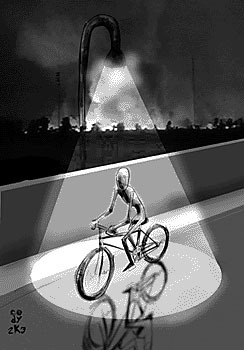
Illustration by Cody Angell
|
By Caitlin Hall
Arizona Daily Wildcat
Thursday April 17, 2003
Last December, a friend of mine, Andria Ligas, was killed biking along North Euclid Avenue just north of the university. A 19-year-old senior, Andria maintained a 4.0 while working three jobs, competing in (and winning) near-weekly triathlons, serving as co-president of the campus climbing club and as an officer in several other organizations, and creating artwork to rival that of many studio art majors. In short, she was extraordinary.
This isn't a eulogy, though. I mention her only to say this: Her death, and everything about it, is a shame. She should have been wearing a helmet. The man driving the van that hit her should have been paying more attention.
More to the point of this column, though: There should have been lights and a bike lane on North Euclid Avenue ÷ and there should be on North Park Avenue, as well.
This isn't a matter of assigning blame; it's a matter of common sense and public safety. Andria was not the only one whose life was endangered by the poor lighting and lack of space for bikes on the roads near UA. The City of Tucson, despite all lip service to the contrary, is not a bike-friendly town. Out in the Foothills and in neighborhoods miles away from the city center, it may be a different story. But on the outskirts of the UA campus, where there is doubtless the highest density of bike traffic anywhere in Tucson, little has been done to promote the safety of cyclists.
The situation is just as dire for pedestrians, who often find themselves dodging cars on North Park Avenue and East University Boulevard and yielding the right of way at stop signs and crosswalks to irritated and careless drivers.
These threads ÷ inadequate lighting, cyclist-hostile roads and aggressive drivers ÷ all have a common root: terrible city planning.
Light pollution is, of course, a concern for a community home to a major observatory. However, there are a number of lighting methods ÷ many of them employed on campus ÷ that would make the surrounding area safer without doing much damage.
However, perhaps the most pressing concern as far as traffic safety goes is North Park Avenue. The street was never meant to handle a high volume of traffic, but the paucity of available parking on campus has meant many more students are being picked up and dropped off ÷ and that North Park Avenue is being used as a vehicular vein in a way that planners never anticipated.
The problem is exacerbated by the lack of a left-hand turn arrow at Park and East Speedway Boulevard ÷ the left lane of traffic on west-bound East Speedway Boulevard backs up and motorists get frustrated, leading them to run red lights and tear through campus at reckless speeds.
As discussed in the Wildcat last week, though, the solution isn't as easy as installing a turn arrow. Doing so would only throw a wrench in the precise coordination of the lights on East Speedway Boulevard, and would probably cause further back-ups. Instead, the city should examine a radically different option ÷ shutting down North Park Avenue between East Speedway Boulevard and East Fifth Street altogether.
If North Park Avenue were closed to motor traffic like many of the streets on campus, it would force traffic onto North Euclid Avenue, which has a left-hand turn arrow at East Speedway Boulevard and is much better equipped to deal with high traffic flow. Doing so would do more for the safety of cyclists and pedestrians than additional lighting or room: It would allow them to travel from class to near-campus housing and restaurants without the fear of being mowed down by aggravated drivers late for class.
The objection might be raised ÷ and has been, by city planners ÷ that such a closure would damage businesses on North Park Avenue. However, many of those businesses ÷ the restaurants at North Park Avenue and East Speedway Boulevard, Carl's Jr. and Bank One ÷ would still be accessible from other roads. Those that aren't ÷ Campus Cuts, Domino's, Lucky Chinese, Arizona Print/Copy and Postner's Art Store ÷ don't seem to be doing getting much business from the off-campus crowd anyway, if the often-empty lone parking spaces in front of them are any indication.
For all its flaws, the dearth of traffic and noise pollution on the ASU campus make it a much more pleasant and safe place than UA for pedestrians and cyclists. As city planners study traffic around campus for the next month, searching for a solution to the problem at North Park Avenue and East Speedway Boulevard, they should look to ASU for an example of the type of traffic a college campus should cater to, rather than putting the concerns of motorists first.
Thus far, the city has done a great disservice to those who walk and bike near campus, but it has a chance to make up for it now. For the sake of the safety of UA students, let's hope it does so.

